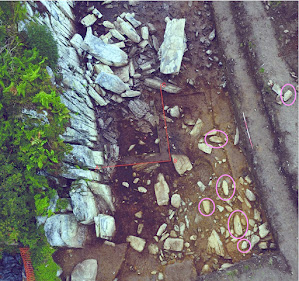My new article on the Limeslade erratic is published today in the journal Quaternary Newsletter.
Details:
Brian John, 2024. An Igneous Erratic at Limeslade, Gower & the Glaciation of the Bristol Channel. Quaternary Newsletter 162, June 2024. pp 4 - 14.
The article is freely accessible, and can be downloaded here:
https://www.qra.org.uk/quaternary-newsletter/quaternary-newsletter-current/
It is also on Researchgate, and can be accessed here:
Thanks are due to Phil Morgan, Prof Tim Darvill and Dr Steve Parry for their help on the technical front, and to Prof Peter Kokelaar and Dr Katie Preece for their notes on the petrology and surface characteristics of the boulder. The biggest thanks of all go to Phil Holden, who found the boulder while scrambling about on Limeslade beach! Other very helpful comments came from Prof John Hiemstra, Prof Danny McCarroll, Olwen Williams-Thorpe, my late friend Dr Dyfed Elis-Gruffydd, editor Dr Ed Garrett and the anonymous referees.
ABSTRACT
A large unspotted dolerite erratic boulder was discovered in 2022 on the rocky foreshore in Limeslade Bay near the SE tip of the Gower Peninsula. It is about 2.2m long, weighs about 5 tonnes and rests in a gully where it is subjected to wave action at every rise and fall of the tide. Its surface is heavily abraded and it may have been substantially reduced in size since its original emplacement. It has a greenish colour and is described as a metamorphosed coarse dolerite or ophitic microgabbro. Thin section analysis and pXRF analysis suggest that it is not related to the spotted and unspotted dolerites of Mynydd Preseli, and that it is most likely to have come from one of the Ordovician igneous outcrops near the north Pembrokeshire coast between St Davids and Fishguard. It is not known whether the rock type is precisely matched in any of the bluestones (monoliths or rock fragments) in the Stonehenge landscape. It is unlikely that this erratic was transported by floating ice, since near the peak of a glacial episode sea-level must have been at least 80m lower than it is today. Further, of the scores of known glacial erratics on the shores of the Bristol Channel, many are found at altitudes in excess of 100m, indicating that during at least one glacial episode the ice of the Irish Sea Ice Stream was thick enough and dynamic enough to press inland across the coasts of Devon and Cornwall. It is therefore probable that glacier ice also reached Salisbury Plain, and that the bluestone boulders and smaller fragments at Stonehenge — from more than 30 different sources — were glacially transported.https://www.researchgate.net/publication/ 328413421_Evidence_for_extensive_ice_cover_on_the_Isles_of_Scilly/figures?lo=1
Brian John, 2018. EVIDENCE FOR EXTENSIVE ICE COVER ON THE ISLES OF SCILLY. Quaternary Newsletter Vol. 146, October 2018, pp 3-27.
ABSTRACT
Previous studies of the Quaternary sediments on the Isles of Scilly have suggested that the ice of the Late Devensian Irish Sea Glacier impinged upon the north coasts of the islands but that it did not extend much further south. There is also disagreement in the literature about whether any earlier glacial episode affected the islands, although a number of researchers have noted the presence of erratic cobbles in pre-Devensian raised beaches. The new field research, based in part upon examinations of exposures that might not have been available to earlier researchers, shows that erratic cobbles and pebbles are common in raised beaches and in early and middle Devensian brecciated slope deposits around all of the island coasts. The most parsimonious explanation is that they have come from disaggregated glacial deposits dating from at least one glacial episode (Anglian?) during which the islands were completely inundated by ice. Furthermore, coherent diamictons similar to those found on the north coasts of the islands, and in western and southern Pembrokeshire, are also found on the coasts of St Mary’s and St Agnes islands, indicating that the Devensian ice cover was more extensive than previously suggested. It appears that ice from the Celtic Sea pressed into the archipelago from the north-west and west, with lobes fingering into sounds and straits which are currently below sea-level. The diamictons, rich in striated and faceted erratic cobbles and pebbles from many different lithologies, do not appear to be primary tills; they are suggestive of an ice-margin environment in which disaggregation and redistribution of glacial and glaciofluvial sediments has occurred. The new interpretation of Late Glacial Maximum ice extent is consistent with other recent work which places the limit of the Irish Sea / Celtic Sea ice lobe around 250 km south-west of the Isles of Scilly, near the Celtic Sea shelf edge.
Citation:
John, B.S. 2023. Was there a Late Devensian ice-free corridor in Pembrokeshire? Quaternary Newsletter 158, pp 5-16.
An ice-free enclave or corridor covering most of Pembrokeshire has featured in many of the recent reconstructions of glacial activity in western Britain during the LGM. This appears to be a hangover from the days when the terms "Older Drift" and "Newer Drift" were frequently used in the literature. However, the supposed ice-free corridor is not well supported in published studies, and it causes difficulty for those involved in ice-sheet modelling. With the aid of new field observations from scores of sites across West Wales, it is suggested that there is no convincing evidence in support of the ice-free hypothesis. The regional Quaternary stratigraphy in Central and South Pembrokeshire matches that of North Pembrokeshire and the St Brides Bay coast, and it is suggested that the whole of the peninsula was inundated by the ice of the Irish Sea Ice Stream travelling broadly NW to SE at the time of peak glaciation, around 26,000 years ago.


























